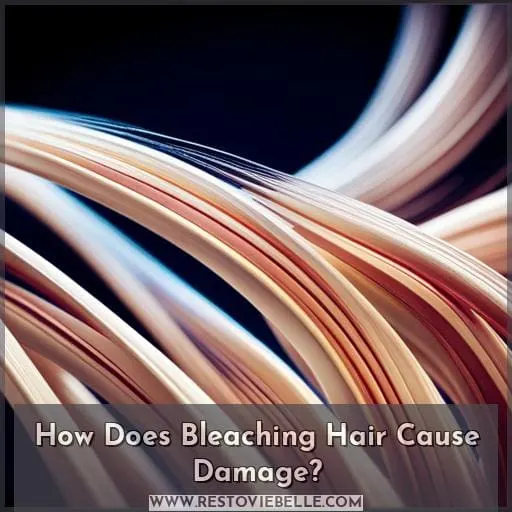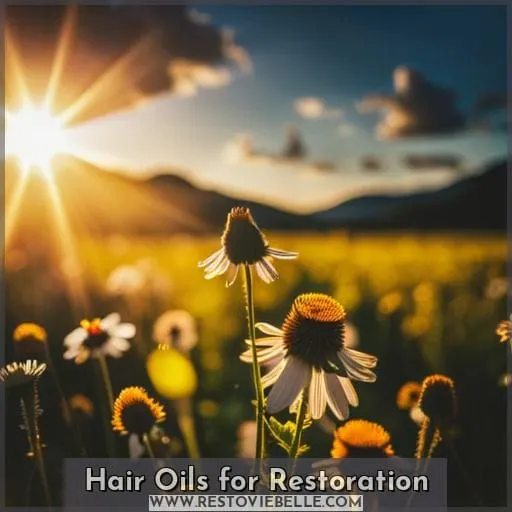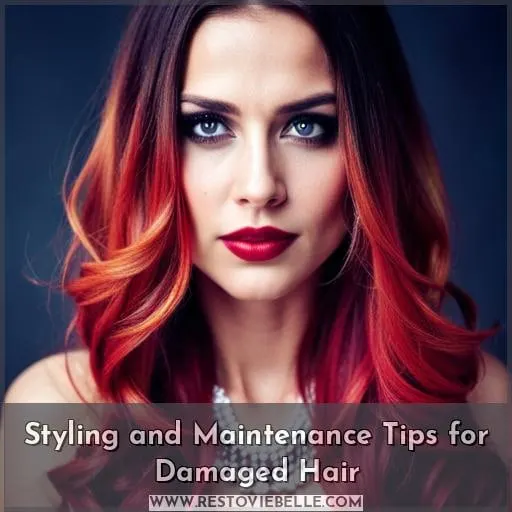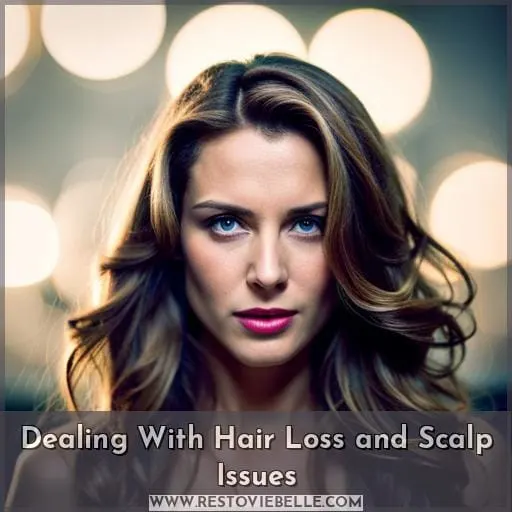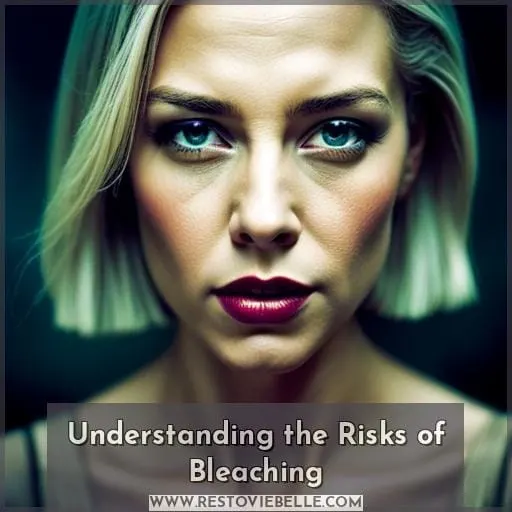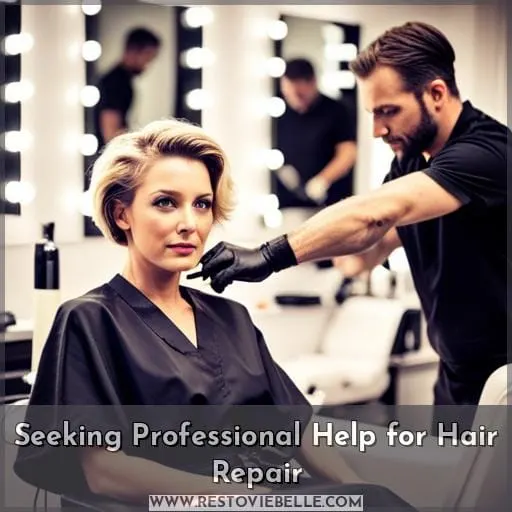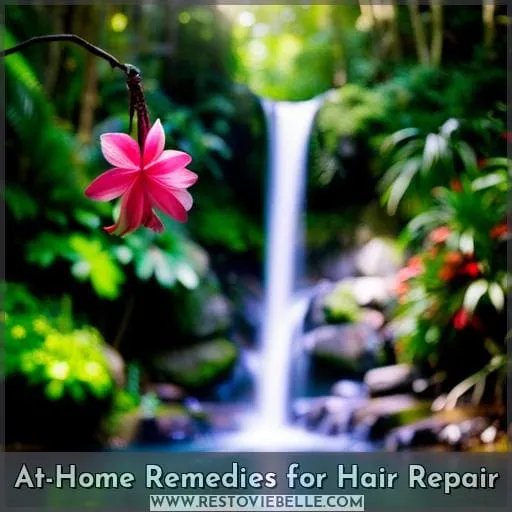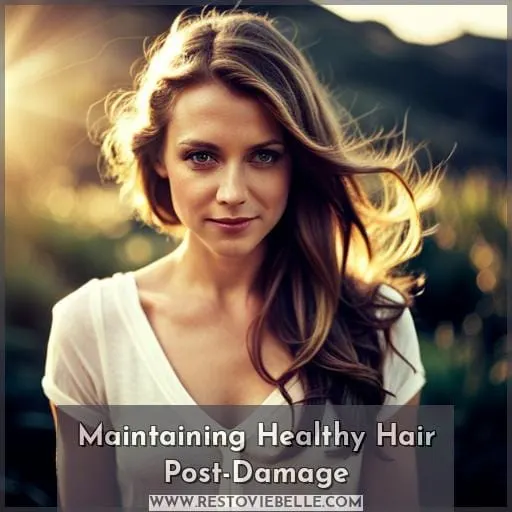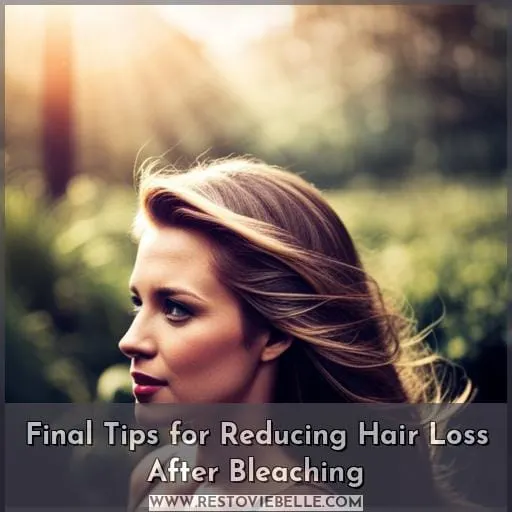This site is supported by our readers. We may earn a commission, at no cost to you, if you purchase through links.
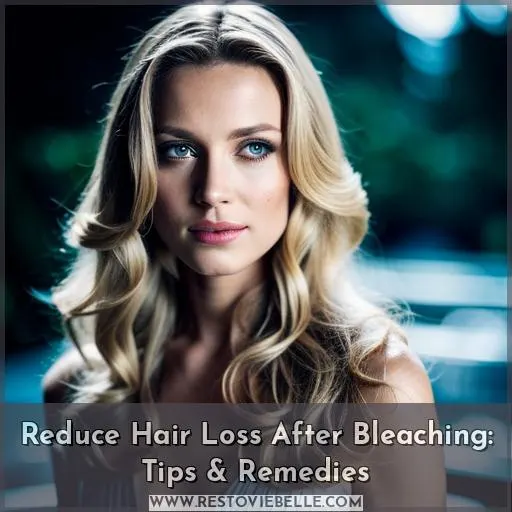 Are you looking for ways to reduce hair loss after bleaching? Unfortunately, most hair lightening products contain bleach, which can cause significant damage. Fortunately, there are a variety of tips and remedies that can help restore your hair’s strength and softness.
Are you looking for ways to reduce hair loss after bleaching? Unfortunately, most hair lightening products contain bleach, which can cause significant damage. Fortunately, there are a variety of tips and remedies that can help restore your hair’s strength and softness.
From protective styling methods to at-home treatments such as protein masks and oiling your scalp – we have everything you need to know about reducing the effects of bleaching on your precious locks! Read further for more information on how to reduce hair loss after bleaching.
Table Of Contents
- Key Takeaways
- How Does Bleaching Hair Cause Damage?
- Hair Oils for Restoration
- Protecting Your Hair From Heat and Sun
- Styling and Maintenance Tips for Damaged Hair
- Dealing With Hair Loss and Scalp Issues
- Understanding the Risks of Bleaching
- Seeking Professional Help for Hair Repair
- At-Home Remedies for Hair Repair
- Maintaining Healthy Hair Post-Damage
- Final Tips for Reducing Hair Loss After Bleaching
- Conclusion
Key Takeaways
- Seek professional help if hair loss persists after bleaching.
- Use protein treatments, natural oils, vitamin supplements, and serums for hair repair and strengthening.
- Deep condition regularly to retain moisture and prevent further damage.
- Protect hair from UV damage by using sunscreen, hats, and protective clothing.
How Does Bleaching Hair Cause Damage?
Bleaching your hair can lead to weakened strands, breakage, frizziness, and dryness due to the hydrogen peroxide and ammonia content in bleach. However, you can protect yourself from these damaging effects by following some of our tips.
Bleaching or coloring hair leads to significant protein loss, which makes it appear thinner. Misuse of harsh chemicals results in severe damage and breakage, as well as scalp irritation that causes temporary hair loss (telogen effluvium).
To prevent this kind of damage, a bond repairing treatment is recommended for strengthening damaged hair’s bonds, while advanced bond rebuilding technology ensures resilient bleached hair.
A deep conditioning treatment helps with moisture retention, as well as limiting heat styling. Using sun protection prevents heat and UV rays from further damaging your locks. Regularly trimming split ends promotes healthy growth, along with other treatments like onion juice or rosemary oil for encouraging regrowth if experiencing noticeable thinning out due to frequent bleaching.
Finally, use daily shield sprays or serums against air pollution, heating and cooling systems, and UV radiation.
Hair Oils for Restoration
When it comes to restoring hair strength and softness after bleaching, an array of oils can be used to promote healthy locks. Olive oil, coconut oil, argan oil, and almond oil are all excellent options for nourishing your tresses post-bleach.
Apply them directly onto the ends or use them in a deep conditioning mask for extra moisture and shine.
Olive Oil
Restore your hair’s strength and softness after bleaching with a few drops of olive oil! Olive oil is packed with essential fatty acids that nourish and hydrate the scalp, aiding in hair growth. Its antioxidant properties help protect strands from damage caused by bleaching chemicals.
Apply directly to dry, frizzy spots or ends before shampooing for an extra boost of moisture. For the best results, incorporate olive oil into your regular conditioning routine. This routine should include deep-conditioning masks weekly to maintain healthy locks post-bleach.
If you’re looking for alternatives to olive oil, coconut or almond oils are also effective. They prevent breakage and provide intense hydration without weighing down the hair shafts.
Coconut Oil
Warm and apply coconut oil to dry, frizzy spots and ends for lasting moisture and shine. Coconut oil helps reduce hair loss after bleaching due to its rich fatty acid content, which enhances hair strength.
It is also known for its anti-inflammatory properties that soothe the scalp while preventing protein loss of the strands from heat exposure. When using coconut oil, be sure not to leave it on overnight as this can clog pores, leading to breakouts or irritation on your face or neck area.
Argan Oil
After bleaching, give your hair the nourishment it needs with a few drops of argan oil for moisture and shine. Argan oil is a great alternative to other oils for frizz control and adding luster. Benefits include improved elasticity, prevention of split ends, protection from UV damage, hydration, and nutrition restoration.
With regular application, it can also help reduce hair loss after bleaching. Include in your repair kit products like conditioner or leave-in serum with this potent ingredient to get the best results; seek professional advice if issues persist beyond 6 weeks post-treatment.
Almond Oil
Treat your tresses to a luxurious almond oil massage, infusing them with moisture and leaving you with lusciously soft hair.
- Rich in vitamins A, E, and B7 for healthy hair growth.
- Enhances keratin production, which helps reduce split ends.
- Conditions the scalp while soothing irritation.
- Loaded with fatty acids that help moisturize dry or damaged strands.
When applying almond oil, be sure to follow precautions such as diluting it first if using directly on the scalp and avoiding contact with the eyes.
By incorporating these natural oils into your regime, you can ensure bleached locks stay strong while reducing breakage due to chlorine exposure.
Protecting Your Hair From Heat and Sun
Protecting your hair from the heat and sun is essential after bleaching to avoid further damage. Sunscreen, DIY masks with ingredients like avocado, honey, and egg white, rinses with rice water, and leave-in conditioner can all help reduce breakage caused by exposure to UV rays or intense temperatures.
Sun Protection
Slather your locks with a sun protection product to shield them from the damaging effects of heat and UV rays. Sunscreen, hats, and protective clothing offer great defense for protecting hair proteins.
For added coverage, don a wide-brimmed hat. It blocks out harmful rays while keeping you cool in hot climates.
DIY Hair Masks
Try whipping up a DIY hair mask to give your bleached locks the extra TLC they need, and don’t forget to include an avocado for that added boost! An avocado mask is packed with vitamins and fatty acids that nourish weakened strands.
For even more hydration, add honey or egg white—both are great natural moisturizers.
You can also try scalp massage with rosemary oil or onion juice if you’re experiencing hair loss after a bleach disaster. Hair oils like olive, coconut, argan, and almond can help restore damaged tresses as well as reduce further damage from heat styling tools.
Keep your bleached mane looking beautiful by using these simple treatments!
Rice Water Rinse
Rinse your hair with rice water for a stronger, healthier-looking mane! Its rich amino acids can help increase the porosity of bleached strands as well as maintain their color. Rice water is also full of vitamins and minerals that are beneficial to hair growth.
Regularly rinsing with it will prevent breakage and keep your locks looking luscious after a chemical mishap or any other form of damage.
Leave-in Conditioner
Apply a leave-in conditioner to your bleached hair for extra moisture and manageability. Leave-in conditioners are specially formulated with lighter ingredients than regular deep conditioning treatments, but still provide essential vitamins, minerals, and nutrients needed after bleaching.
They help reduce breakage by sealing in the natural oils on the scalp while also providing UV protection from sun damage and preventing chlorine damage when swimming.
Styling and Maintenance Tips for Damaged Hair
It is important to take care of bleached hair in order to minimize damage and reduce the risk of losing strands. By following some simple styling and maintenance tips, you can keep your locks looking healthy, soft, and strong.
Avoiding Heat Styling
Limit heat styling to reduce damage and maintain healthy hair. Avoid excessive blow-drying, curling, or straightening. Try heatless styling techniques like air drying with a t-shirt wrap for waves or braiding damp strands for curls.
Hair-friendly hairstyles such as low buns and half up/half down styles can help protect your locks from further damage while still looking fashionable.
Also, don’t forget scalp care. Regular massages increase circulation, promoting the natural growth of healthy hair follicles and helping prevent breakage due to bleaching products used in highlighting or coloring treatments.
Limit the frequency of bleach applications – use only when necessary – to preserve the integrity of your mane!
Chlorine Protection
Beware of chlorine’s damaging effects on bleached hair; rinse before and after swimming to protect your locks. Use a swim cap to keep chemicals out, opt for aloe vera-infused pool water, moisturize with protein treatments, and deep condition weekly.
Chlorine can strip away the cuticle layer that protects your hair from environmental damage, leading to breakage or even worse—hair loss! Regularly use protective products like leave-in conditioners containing keratin or natural oils such as coconut oil when styling post-bleaching.
Proper Hair Detangling
Gently glide your comb or brush through stressed strands to detangle hair and promote healthy growth. Use a wide-toothed comb for wet hair, starting from the ends and working your way up. Choose a soft-bristled brush when dry; it helps reduce breakage by evenly distributing natural oils.
Avoid using tight elastics that can cause knots; instead, opt for fabric scrunchies with gentle hold.
Reducing Shampoo Frequency
Try reducing shampooing frequency to retain natural oils and keep your hair looking lustrous! Scalp massages with peppermint oil, aloe vera, or witch hazel can help soothe any underlying scalp issues. DIY hair masks with avocado, honey, or egg white can also help strengthen strands that have been weakened by bleaching.
Hair breakage should be prevented by avoiding tight ponytails and air-drying when possible. For best results, seek professional help if these methods do not reduce the effects of hair loss after bleaching within 6 weeks’ time.
Wash With Lukewarm and Cool Water
Be sure to finish up your wash with a cool water spritz for softer, smoother strands. Lukewarm benefits hair washing techniques by helping reduce damage and loss from bleaching. A cool water rinse seals moisture in the cuticles, helps flatten them, and locks nutrients into the scalp.
Water temperature effects can also impact split ends or frizz – keep it lukewarm! Temperature impacts on shampooing are clear: use cooler temperatures to reduce damage while hydrating better than hot.
Regular Trimming
Trim split ends regularly to prevent breakage and keep your hair looking its best. Regular trims can reduce the appearance of split ends, encourage healthy growth, and help retain length. Ask your stylist for recommendations on how often you should trim based on the desired hair length.
Hair thickening serums also promote strength while reducing further damage from bleaching or chemical treatments.
Dealing With Hair Loss and Scalp Issues
If you’ve bleached your hair, you may be experiencing some hair loss and scalp issues. Fortunately, there are steps that can be taken to promote regrowth and soothe irritation. These include using natural oils for restoration, protecting from heat and sun damage with DIY masks or rice water rinses, reducing shampoo frequency while detangling carefully with a wide-toothed comb or wet brush.
To prevent further breakage, use lukewarm water when washing the hair, then finish with a cool spritz of water; trimming split ends will also boost overall health.
Promoting Hair Regrowth
Surprise yourself with the power of natural treatments to promote hair regrowth after bleaching! Scalp massages, rosemary oil, and onion juice can support healthier follicles. Avoid tight ponytails and other hairstyles that could pull on hair strands; air dry when possible.
Peppermint oil, aloe vera, or witch hazel can soothe scalp issues, while avocado masks nourish your mane back to life. Address hair loss as soon as you notice it for best results. Make sure not to ignore it! With a few simple steps in place, you’ll be surprised at what regular care will do for your locks post-bleaching journey.
Soothing Scalp Issues
Soothe scalp issues with the healing power of natural oils like peppermint, aloe vera, and witch hazel! Scalp massage benefits include improved blood circulation, while a cool water wash can help prevent hair breakage.
Professional stylists are also able to recommend healthy hair products that provide long-lasting results. Natural remedies such as rosemary oil or onion juice can be used for regrowth if you’re experiencing unwanted loss.
Argan oil works well to lock in moisture after styling. For an extra boost of shine and protection against environmental damage, use daily shield sprays or serums.
With these techniques, your scalp will soon recover from bleaching damage!
Preventing Hair Breakage
Avoid tight ponytails and air-dry when possible to keep your hair from breaking. Limit heat styling, as it is a common cause of breakage. Use protective styling tools like leave-in conditioners, heat protectants, and wide tooth combs to reduce damage from daily wear and tear or bleaching products.
Regular scalp massages stimulate blood circulation for stronger strands. Conditioning treatments with ingredients like olive oil or almond oil hydrate the hair shafts from within. For an extra quick fix after bleaching, try rice water rinses, which are packed full of vitamins that strengthen hair follicles.
With these simple tips, you’ll be able to prevent breakage at home and keep your locks looking beautiful, even after bleach damage!
Understanding the Risks of Bleaching
It’s important to be aware of the risks associated with bleaching your hair, as it can cause protein loss and damage to your scalp health.
- Bleached hair tends to feel thinner due to the loss of lipids, fatty acids, and keratin protein.
- Use sun protection products regularly when exposed to heat or sunlight in order to prevent further weakening from chlorine’s damaging effects on bleach-treated strands.
- Hair breakage is more likely if you’re tying it too tightly into a ponytail or blow drying excessively after a bleach bath has taken place; avoid this where possible!
- Temporary hair shedding (telogen effluvium) could occur depending on how reactive one’s scalp is, so take caution when making decisions about whether or not full head treatments are necessary each time around!
- If persistent thinning continues beyond 6 weeks following treatment, then seeking professional advice may be required in order for any underlying issues regarding potential alopecia to be correctly identified and treated accordingly – ultimately supporting potential regrowth over time through addressing its root causes directly.
It goes without saying that regular maintenance, such as deep conditioning masks, will help keep the condition healthy while limiting exposure times between dye sessions can also reduce excess damage caused by frequent bleaches taking place too closely together.
Seeking Professional Help for Hair Repair
If hair issues persist beyond six weeks, it’s time to seek professional help for repair and maintenance of bleached locks. Consulting a specialist can provide expert advice on how to restore your hair health, while salon solutions may be necessary for deep-conditioning treatments or specialized products that aren’t available over the counter.
Professional Consultation:
- Receive guidance and expert advice
- Diagnose issues and create a treatment plan
- Grow confidence in your hair restoration journey
Hair Restoration:
- Rebuild bonds and strengthen ends
- Tailored plan of action based on individual scalp condition and desired results
Salon Solutions:
- Deep conditioner and bespoke products
- Scalp care and hydration
A one-on-one consultation with an experienced stylist is ideal in order to identify specific needs and create a tailored plan of action based on individual scalp condition and desired results. At-home measures such as heat protection sprays or serums should also be taken into consideration when discussing options with the stylist or beautician who are best placed at providing guidance regarding what will work best for you personally.
At-Home Remedies for Hair Repair
If you’re looking for ways to reduce hair loss after bleaching, there are a few home remedies that may help. Protein treatments, hair masks and oils, vitamin supplements, and using serums can all have positive effects on your damaged locks.
Protein Treatments
Try a protein treatment to rebuild and nourish weakened hair strands. Hair strengthening products can help prevent further damage. A deep-conditioning mask or leave-in conditioner works best for post-bleaching care, replenishing lost moisture and keratin proteins.
Repair with natural oils like coconut, almond, olive, or argan oil to restore softness and shine too!
- Protein treatments, such as deep conditioning masks, can help repair damaged hair after bleaching.
- Natural oils, such as coconut oil, almond oil, olive oil, or argan oil, are good ingredients that will add moisture back into your locks.
- Leave-in conditioners are also beneficial in restoring the health of your hair by providing strength and elasticity.
Hair Masks and Oils
Indulge in hair masks and oils to restore strength and softness after bleaching. Nourish your scalp with avocado masks, benefit from honey, and try egg white recipes for deep conditioning. Refresh strands with oil massages; boost regrowth using rosemary or onion juice remedies.
Vitamin Supplements
Boost your hair’s health with a daily vitamin supplement! Vitamin supplements can help nourish and strengthen bleached hair from within. Dietary support helps keep strands healthy, moisturized, and resilient against breakage.
Hair nutrition is key to restoring damaged tresses; vitamins aid nutrient intake for better scalp circulation and thicker locks. Essential vitamins include Biotin, Vitamin C, Niacinamide (B3), Pantothenic Acid (B5), Zinc, and Iron – all of which contribute to stronger follicles and improved shine! Incorporate these essential nutrients into your routine for the best results in maintaining healthy bleached hair.
Using Hair Serums
Enhance your post-bleach hair with a quality serum for protection and hydration. Hair serums offer a number of benefits, such as smoothing split ends, restoring moisture balance, taming frizzes, boosting shine, and enhancing color vibrancy.
Apply the serum to damp or dry strands using the gloves provided in the packaging. Avoid contact with the scalp as it can be oily or irritated from bleach chemicals.
Serum types vary depending on texture. Light gels are suitable for finer hair, whereas heavy creams work best on thicker locks. Look out for natural ingredients like avocado oil, which hydrates without weighing down hair follicles.
For maximum results, combine different serums tailored specifically to bleached strands. Try using argan oil-based mists before styling and leave-in treatments overnight.
Maintaining Healthy Hair Post-Damage
Having taken the necessary precautions to prepare your hair for bleaching, you’ve done a great job of reducing potential damage. However, if you’ve already experienced some breakage or dryness due to bleaching, there are still ways to restore and maintain healthy hair.
For starters, take preventative measures against further damage. Use hair repair treatments and scalp health products that contain natural ingredients like peppermint oil and aloe vera.
Additionally, consider methods for promoting regrowth. Massage rosemary oil into the scalp or apply onion juice directly onto balding patches of skin once a week. These can help stimulate cell regeneration in areas where new growth is desired.
When it comes to heat protection while styling post-bleach damages, keep in mind to minimize blow drying by letting your locks air dry when possible. Use leave-in conditioners with keratin protein after rinsing off shampoo. Apply heat protectant sprays before curling, straightening, or styling with hot tools.
This will reduce moisture evaporation from heated styling instruments, which could cause more harm than good over time.
Finally, be sure not to trim split ends on occasion so they don’t get worse over time.
Take advantage of all these tips for maintaining strong, luscious locks post-bleach damage! Utilize hair repair treatments, scalp health products, hair regrowth methods, and heat protection and styling tips.
Final Tips for Reducing Hair Loss After Bleaching
To protect your bleached locks, try following some of these tips for reducing hair loss and keeping it healthy.
- Incorporate scalp massage into your routine; rosemary oil or onion juice may help promote regrowth.
- Soothe irritation with peppermint oil, aloe vera, or witch hazel.
- Avoid tight ponytails or air drying when possible to prevent breakage.
- Limit the frequency of bleaching – no more than once every two months and avoid full head applications if possible.
- Seek professional advice if issues persist beyond six weeks after bleach treatments have ended.
Finally, be sure to invest in quality products such as bond repairing treatments and deep conditioning masks that will restore moisture levels while strengthening weakened bonds post bleach sessions for optimal results!
To keep your hair looking its best between appointments, take advantage of heat protection sprays before styling with heated tools, plus daily shields against environmental damage like pollution and UV rays, which all contribute towards further weakening strands from already compromised bleached tresses.
Conclusion
With the right tools and knowledge, you can prevent hair loss after bleaching and keep your hair looking and feeling its best. Bleaching your hair can cause permanent damage if not done correctly, but you can minimize the damage and restore your hair to its former glory with the right techniques and remedies.
As a rule of thumb, limit the frequency of bleaching. Over-bleaching can weaken your hair and lead to excessive hair loss.
Protect your hair from heat and sun. Excessive heat styling and exposure to the sun can further damage your bleached hair and contribute to hair loss. Use heat protectant sprays and wear a hat or use a scarf to shield your hair from the sun’s harmful rays.
Use nourishing hair oils to keep your hair moisturized and healthy. Bleaching can strip your hair of its natural oils, leaving it dry and brittle. Apply hair oils, such as coconut oil or argan oil, regularly to nourish and hydrate your hair.
If you’re struggling with hair loss after bleaching, it’s important to seek professional help. A hair specialist or dermatologist can assess the condition of your hair and provide personalized advice and treatments to promote hair growth and prevent further loss.
By following these tips, you can reduce hair loss after bleaching and keep your hair healthy and strong. Don’t let the fear of hair loss hold you back from bleaching your hair. With proper care and attention, you can enjoy the beautiful results of bleaching without sacrificing the health of your hair.

